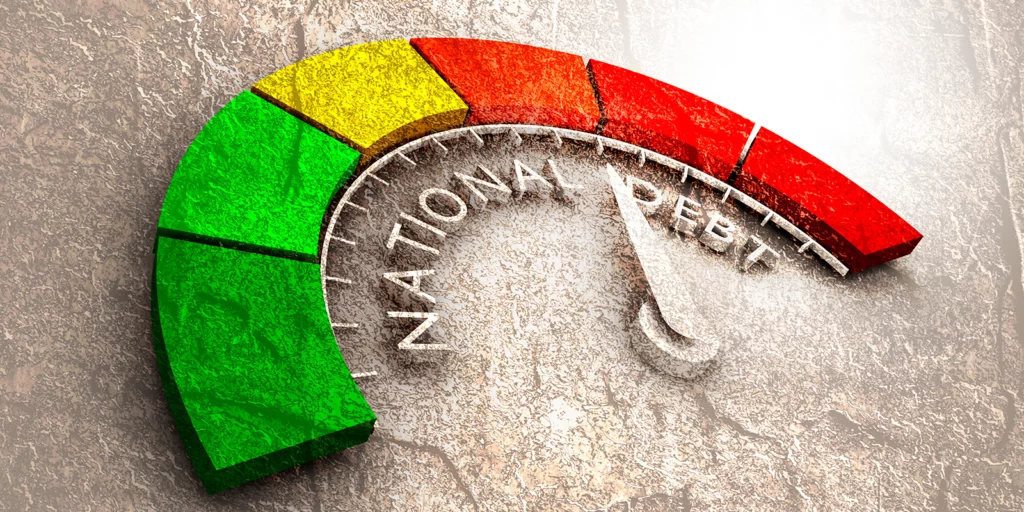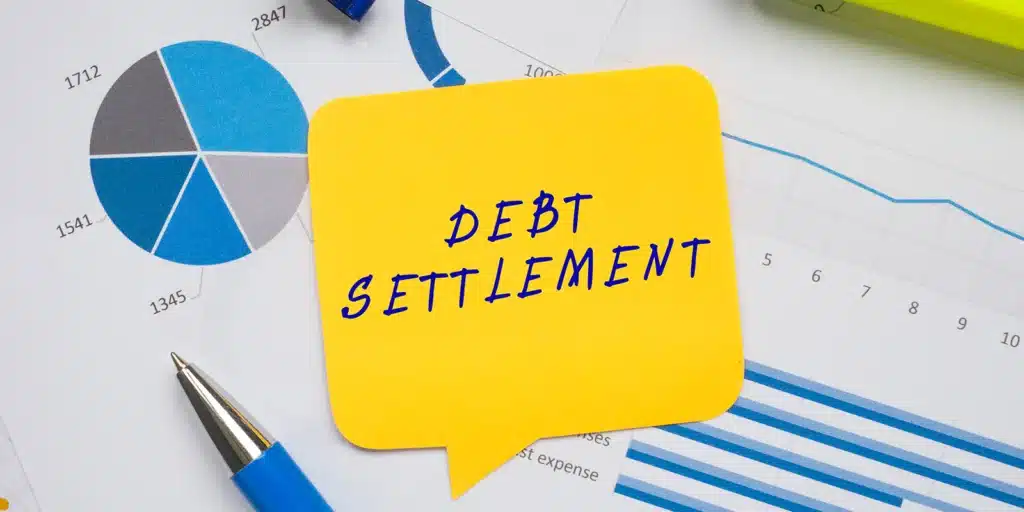U.S. National Debt Tops $31 Trillion for the First Time: Info & Options for Overcoming Debt
Posted on October 12, 2022 in Debt
Due to high inflation, rising federal interest rates, and growing economic uncertainty, America’s national debt has surpassed a record $31 trillion for the first time.
- U.S. National Debt
- What Causes National Debt?
- Effects of Record U.S. National Debt
- Overcoming U.S. National Debt
- Debt Relief Methods to Combat America’s Rising National Debt
- Final Thoughts on America’s New National Debt Record
Debt – it sounds as normal as brushing your teeth when you wake up, but it isn’t always good for you! Yes, it allows for easier planning, builds your credit score (if well managed), and allows you to increase your return on investment, but it can also rob your future.
And if you are struggling with debt, you are not the only one; you join tens of millions of Americans with the debt problem. Also, a recent report shows that the U.S. national debt stands above $31 trillion, the a record high for the country. This means that each person has a debt of approximately $94,315.
This post will discuss the U.S. national debt record, including its effects on Americans, and how to overcome debt. We’ll also discuss the various debt relief programs for Americans.
Let’s get started!
U.S. National Debt
Also known as country debt, government debt, or sovereign debt, the national debt is the debt owed by the federal government. The U.S. national debt comprises two types of debt: intragovernmental debt and debt held by the public.
Intragovernmental debt is the debt owed by the federal government to other government departments. On the other hand, debt held by the public is what the government owes to Treasury investors, including local people, international investors, and foreign governments.
For years, America’s borrowing has been considered sustainable because of low-interest rates. However, as the rates rise, the country’s fiscal worsens.
A recent treasury report shows that the national debt has surpassed $31 trillion for the first time, a milestone that comes amid rising interest rates, high inflation and economic uncertainty. Yes, national debt bridges the fiscal deficits of a country, prevents a deeper recession and helps finance huge infrastructure development projects, but it can also hurt the economy.
What Causes National Debt?
Government spending is the main cause of national debt. The spending leads to a budget deficit, but it’s vital for economic growth. The government pumps money into the economy and uses budgetary tools to cut taxes or increase spending. This provides businesses and consumers with more money to spend, which boosts economic growth over the short term.
But the government must spend money to boost the economy, which adds to the national debt. Let’s go through the effects of the national debt on the U.S.
Effects of Record U.S. National Debt
The rising interest rates will aggravate the country’s growing debt problems and make the debt costlier. To combat inflation, the Federal Reserve has raised rates several times this year, which adds to the debt issue.
The rising national debt threatens America’s future in several ways, including:
1. Reduced public investment
With increased national debt, the government is more likely to spend more of its budget on interest costs, which crowds out public investments. And with the U.S. spending more than $965 million daily on interest payments, there is less left to invest in areas that promote economic growth.
2. Reduced national savings and income
Huge sustained federal deficits decrease investments and lead to higher interest rates. And with more federal borrowing, a higher percentage of savings is redirected towards government securities. This reduces the amount invested in private ventures, making the workforce less productive.
3. Reduced economic opportunities for Americans
Increased national debt also directly affects the economic opportunities available to Americans. If the national debt crowds private and public investments, employees will have less to use in their jobs, which translates to reduced productivity and lower wages.
Also, high national debt levels would affect many other aspects of the economy in the future. For instance, higher interest rates from increased federal debts would make it challenging for families to finance car payments, buy homes, or pay for college.
4. Risks of a fiscal crisis
With deteriorated nation’s fiscal position, interest rates on federal borrowing are likely to increase as higher yields will be demanded to buy such securities. Also, a rapid increase in the Treasury rates can increase inflation rates, reducing the value of outstanding government securities.
5. Challenges to national security
The country’s fiscal security is closely linked to national security and the ability to maintain a leading role worldwide. Experts will tell you that a country’s debt is among the most significant national security threats. As the national debt increase, the country will be more indebted to creditors worldwide and have fewer resources to invest in strength at home.
Overcoming U.S. National Debt
The U.S. can do a few things to overcome or reduce the national debt problems. For instance, the government could cut spending or raise taxes to reduce the debt. These are two of the tools of contractionary fiscal policy, and either of the tactics can slow down economic growth.

But spending cuts come with several drawbacks, however. Cutting the spending too much will make the GDP drop and slow economic growth. In turn, this leads to fewer revenues and a larger deficit.
Also, increasing taxes can lead to slow economic growth. Research shows that increasing the tax by 1% lowers the real GDP by about 3%. The real GDP is an inflation-adjusted measure that makes it easy to track GDP from year to year.
Lenders will be confident that the government will repay them, provided the debt is below the tipping point. The tipping point is when the amount of public debt inhibits the nation’s ability to grow economically.
If the debt stays moderate, the government interest rates will remain low, allowing the government to keep the deficit for several years.
Debt Relief Methods to Combat America’s Rising National Debt
If you are struggling with credit card debt or having trouble meeting your monthly payments, you join millions of Americans with the same problem. The good news is that you can adopt a debt relief solution to tackle your financial problems and walk debt free.
Not all debt-relief programs will work for consumers. The success of a program in solving your financial issues will depend on your goals, commitment, and resources. Knowing what type of debt relief program is right for you is key to finding a solution that matches your specific goals.
Here are the five best debt relief programs to help combat rising U.S. national debt:
1. Credit counselling
Credit counselling involves discussing your credit with a qualified, trained budgeting and consumer finance professional. They offer unbiased guidance regarding your credit status. Credit counselling helps you review spending, create a budget, prioritize debts, and establish a debt management plan.
It’s ideal for people who:
- Need help creating a budget
- Want free credit advice
- Have no idea where to start with credit clearance
- Want a debt management plan
2. Debt consolidation
Debt consolidation involves taking out a loan to pay off the existing line of credit, thus replacing them with one monthly payment. This debt-relief program allows you to eliminate your debts over an extended period.
You should turn to debt consolidation if you have several debts with higher interest rates. Consolidating the lines of credit into a single loan makes sense if you end up with a lower-rate loan. It can also help boost your credit score by affecting your credit utilization.
Debt consolidation is ideal for those who:
- Seek long-term solution
- Have several lines of credit
- Qualify for a lower interest rate
- Have a huge amount of debt
Note: Debt consolidation is not a free service, and the loan may come with additional costs other than the interest rates.
3. Debt forgiveness
As the name suggests, debt forgiveness happens when a lender forgives all or some of a borrower’s outstanding balance on their credit account. However, you must qualify for a special program for the lender to erase your debt.
And while it sounds like a lucrative solution, debt forgiveness isn’t always the best. It’s surrounded by fraud and has its cons, including taxes.
Debt forgiveness is ideal for those who:
- Qualify for federal loan forgiveness programs
- Have a severe injury or illness
- Have financial hardship
4. Debt settlement
This method involves negotiating with your lenders to minimize the total balance by offering to pay a portion of it in full. You can negotiate a debt settlement on your own or seek the help of a debt settlement firm.

If you choose a debt settlement company, they’ll contact the creditors on your behalf, run your credit reports, and prioritize what debts to tackle first. And if you are lucky enough, you may get a creditor willing to accept as much as half of the initial total debt.
Debt settlement is ideal for those who:
- Have charged off accounts
- Have accounts in the collection
- Have recent debts
- Can make regular payments.
Note: Debt settlement may demand that you pay additional taxes at the end of a fiscal year. The forgiven money is considered taxable income by the IRS.
5. Bankruptcy
If your debt is skyrocketing and you can’t find a way out of it, you may consider bankruptcy. Chapter 7 bankruptcy allows you to do away with all your outstanding debts and protects you from losing assets like retirement benefits and savings.
Filing for bankruptcy will severely damage your credit score. Bankruptcy should only be used as a last resort after exploring other options. You may need to seek the help of a qualified bankruptcy attorney to see you through the process.
Bankruptcy is ideal for those who:
- Have severely damaged credit
- Are overwhelmed with debt
- Can’t repay their debts
Final Thoughts on America’s New National Debt Record
A sustainable fiscal path creates a positive environment for growth, prosperity, and opportunity. The country will have more resources for future investments, increased access to capital, and a stronger safety net with a better fiscal foundation.
However, the rising national debt threatens the country’s fiscal foundations in several ways. For instance, increased federal borrowing risks a fiscal crisis, reduces national savings and income, decreases public and private investments, etc. This article discusses the U.S. national debt, including how it affects the U.S. economy and how to overcome it.
Related blog posts
Need expert financial advice?
Let TurboFinance connect you with the best consulting services and resources to help you take control of your finances and find a path to build wealth.
Get A Free Consultation Today!